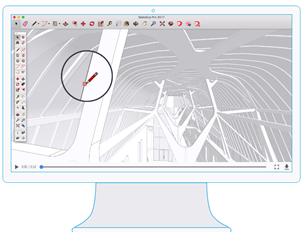Cracks in the System
Cybersecurity threats don’t always kick the door down—sometimes, they slip in through the cracks. This month, we’re spotlighting three subtle but serious security risks that could be undermining your defences right now.

3D Modelling tools are becoming increasingly popular and with new advances in technology, the process is ever changing, but there are still key issues that have yet to be resolved.
 A conceptual modelling solution like SketchUp is extremely affordable, allowing you to have more users for less investment and it doesn’t require overly powerful hardware to run.
A conceptual modelling solution like SketchUp is extremely affordable, allowing you to have more users for less investment and it doesn’t require overly powerful hardware to run.
SketchUp Pro is intuitive and quick to learn, enabling more participation and collaboration across workflows. It’s a flexible platform that enables creativity and more design iterations within project timeframes. It also enables the BIM you need to meet industry standards, with a focus on efficiency and collaboration.
SketchUp offers significantly reduced ongoing and upfront costs for software. It also reduces investment in manpower, training and high-end desktop machines in the business.

Sketchup is known across the world, and at the time of writing this blog it boasts an impressive 33 million annual activations and over 1bn completed projects. It also has a huge social media presence, with over 370k Facebook likes, 109k Twitter followers and 759k Google+ followers.
SketchUp Pro includes LayOut for the creation of comprehensive 2D documentation and Stylebuilder which allows you to import your own pen strokes, showcasing unique drawing styles. With full integration for Extension Warehouse, users have access to over 400 free and paid extensions to enhance their workflow. And for truly rapid modelling, browse over 4M models on 3D Warehouse to quickly populate scenes.
SketchUp really does drive creativity, productivity, communication, and delivers superb conceptual design results. It allows designers to quickly and easily turn ideas into built form in the virtual space. This quick visualisation process allows stakeholders to move through fast-paced early design stages in a much more streamlined way.
Cybersecurity threats don’t always kick the door down—sometimes, they slip in through the cracks. This month, we’re spotlighting three subtle but serious security risks that could be undermining your defences right now.
As 2025 comes to a close, we’re looking back at some of the most impactful cyber threats of the year and more importantly, what they reveal about the challenges ahead. From ransomware tactics to AI-driven phishing and risky app integrations, this round-up highlights where businesses have been most vulnerable and how you can strengthen your defences in 2026.
Learn what Product Lifecycle Management (PLM) is and how it helps teams manage product data, processes, and collaboration across the lifecycle. Discover the key benefits and PLM tools driving innovation.
